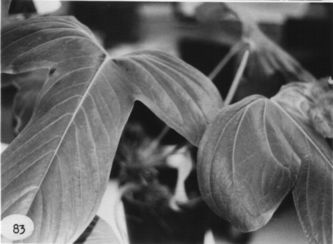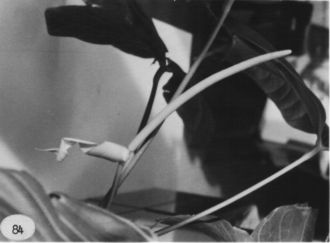



Anthurium garagaranum Standl.,
Publ. Field Mus. Nat. Hist., Bot. Ser. 22: 68. 1940. TYPE: Panama. Darien: foothills of Garagara, 30-500 m, Feb. 1912, Pittier 5601 (US, holo-type; MO 1292151, photo).
Epiphytic creeper; stem green, smooth, to 2 cm diam., leaf scars obscured by roots and persisting cataphyll fibers; cataphylls 6-8 cm long, drying brown, weathering to longitudinal fibers, remaining intact at apex, persisting.
LEAVES with petioles spreading, (12-)20-77 cm long, 0.8-1 cm diam., subterete; geniculum 1.2-1.7 cm long, weakly sulcate; blades subcoriaceous, juvenile blades oblong, adult blade 3-lobed, median lobe acuminate at apex, (22-)31-67 cm long, 8.5-18 cm wide, usually broadest above middle, lateral lobes 14-39 cm long, 9-29 cm wide, usually at right angle to median lobe, sometimes weakly falcate; upper surface matte, lower surface semiglossy, much paler; midrib acutely raised and paler than surface above, diminishing and sunken toward apex, convexly raised below; basal veins 4-6 pairs, the first sometimes free, usually all veins coalesced (1.5-)5.5-10 cm, forming thick upturned posterior rib, raised above and paler than surface, raised below; primary lateral veins 6-9 per side, departing the midrib at 40-60ˇ angle (sometimes at a 25-30ˇ angle in juvenile blades), straight to collective vein, raised near midrib, sunken near collective vein, raised below; lesser veins scarcely visible; collective vein of the median lobe arising from one of the primary lateral veins m the apical half of the blade (sometimes from a primary lateral vein in the basal half of the blade, rarely from the first basal vein in juvenile blades); sunken above, raised below, usually scarcely removed from the margin.
INFLORESCENCE erect-spreading, shorter than petiole; spathe pale green, subcoriaceous, lanceolate, 11-34 cm long, 1.8-2.3 cm wide, broadest near middle or just below, long-acuminate at apex, acute at base, usually strongly reflexed; spadix stipitate to 1 cm, bright golden yellow, (12-)23-47.5 cm long, 0.6-1.6 cm diam. at base, 3-6 mm diam. near apex; flowers rhombic to 4-lobed, 2-2.4 mm long, 1.2-1.5 mm wide, the sides straight to weakly sigmoid; 12-15 flowers visible in the principal spiral, 15 or more flowers visible in the alternate spiral; tepals glossy 0.5-0.7 mm wide, the inner margin convex; pistils scarcely emergent; stigmas elliptic, 0.5 mm long, brush-like; stamens not emerging, pollen gold, oozing from between pistil and tepals in ribbons and held around edges of tepals; anthers and thecae not visible.
INFRUCTESCENCE with purple to dark violet purple oblong-elliptic berries, white at base, purplish at apex or purple; seeds 2, oblong-elliptic, brownish, 2.8-4 mm long, 1.5-2 mm wide, 1.1-1.3 mm thick enveloped in a sticky mucilaginous substance. Figs. 83 and 84.
Anthurium garagaranum ranges from Central Panama to Colombia (Departments of Choco and Valle) at elevations ranging usually from near sea level to 900 m, but rarely to 1,400 m, usually occurring in tropical wet or premontane forest life zones, rarely in lower montane wet forest.
The species is in section Semaeophyllium and is distinguished by its three-lobed leaf blades, its long-tapered, yellow to orange-yellow (at anthesis) spadix, its large linear-lanceolate spathe, and by its purple to purple and white (at base) berries. One collection (Gentry et al. 16853) reports the fruit to be white. At anthesis the spadix is sweetly aromatic and has been observed being visited by the euglossine bee Eulaema polychrome. (Kennedy & Dressier 2983).
The single collection seen from Valle Department in Colombia (Cuatrecasas 16457) has a much stouter spadix and lacks the stout naked posterior rib associated with Panamanian material but otherwise appears to be this species. A specimen with an immature spadix (Daniel 2 584) from Antioquia appears also to be this species.
Anthurium garagaranum was included with A. trilobum Linden ex Andre by Madison (1978), but material attributed to that species is A. cineraceum, A. furcatum Sodiro, or A. falcatum Sodiro, and A. trilobum is now considered a synonym of A. signatum C. Koch & Mathieu of western Venezuela. Anthurium insigne Mast., a species from western Colombia, is similar to A. garagaranum in having bright yellow spadices at anthesis (never orange or reddish as reported by Madison, 1978) but differs in having shorter spadices that dry brownish and matte, not glossy and blackened as in A. garagaranum. In addition A. insigne has fewer flowers per spiral (seven to eight) and stamens exserted with the intact thecae exposed on dried specimens. Anthurium garagaranum, on the other hand, has stamens that are never exposed (see description above).
Anthurium garagaranum may also be confused with A. cineraceum where the two species occur together in far western Panama and in Colombia in Choco Department. The latter species differs in having spadices with fewer flowers per spiral (seven to 12), spadices that dry matte and frequently reddish brown rather than semiglossy and blackened, and leaf blades that dry typically grayish rather than greenish brown to dark brown as in A. garagaranum.
Anthurium garagaranum is perhaps most closely related to A. subsignatum Schott and may ultimately prove to be merely a subspecies of that species. The latter differs in being generally a more scandent species and by having generally smaller leaves that are more shallowly lobed.
Panamanian material of Anthurium garagaranum typically has shorter, more rounded lateral lobes, whereas material collected in the Choco Department of Colombia has lateral leaflets more elongate and pointed at the apex.
 |
 |
Map of Mesoamerican specimens with coordinates
Panama CoclŽ: 680-770 m, 08.39N 80.36W, 25 March 1993, Thomas B. Croat 74826 (MO).Map of South American Specimens with coordinates
Colombia Antioquia:, Dec 1940, Daniel et al. 2584 (US).